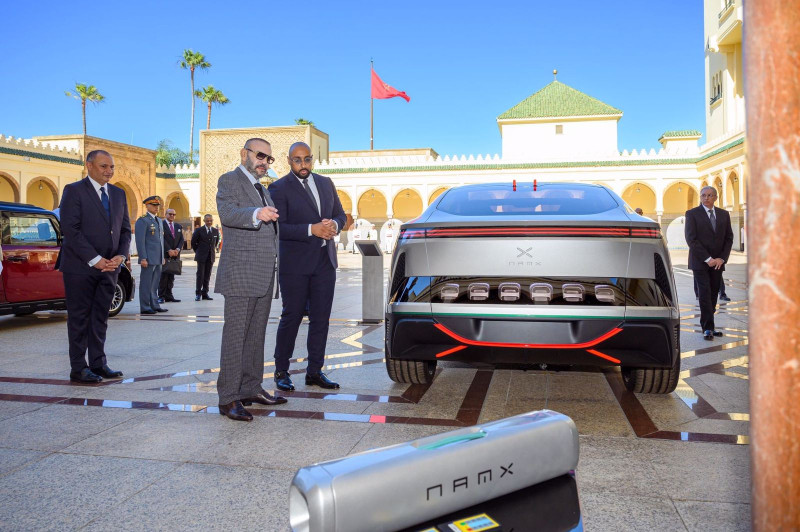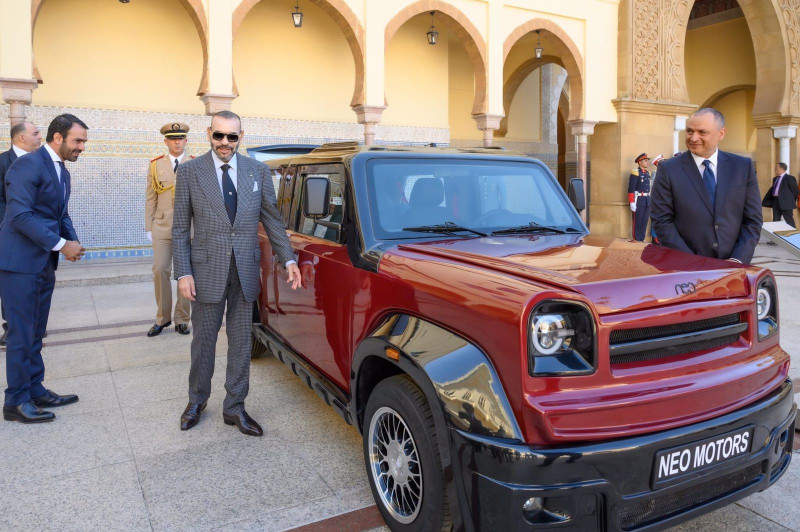In a ceremony held on Monday at the Royal Palace in Rabat, King Mohammed VI was presented with a model of the first Moroccan automobile brand and a hydrogen-powered vehicle prototype by Neo Motors CEO Nassim Belkhayat and NamX President Faouzi Annajah.
The initiatives, created by Moroccan businesspeople, mark an important turning point for the nation and will support the “Made In Morocco” branding and position Morocco as a competitive hub for automobile manufacture.
The prototype of NamX’s hydrogen vehicle, the Hydrogen Utility Vehicle (HUV), and a replica of the “Neo Motors” automobile, a business owned by Moroccan capital, were both on display for the King to inspect.
The Rabat-Sale-Kenitra Region’s Ain Aouda presently has an industrial complex under construction by Neo Motors. The strategy focuses on producing automobiles for both the domestic market and export.
The factory is expected to be able to produce 27,000 units per year. It cost MAD 156 million ($15 million) to build and is anticipated to generate 580 jobs.
The National Agency for Road Safety gave final certification to the first car produced by Neo Motors in February 2023. Pre-production was started by the business, and the plant’s opening was set for June 2023.
The Italian design firm and coachbuilder Pininfarina collaborated with NamX to create the hydrogen-powered automobile. The car’s interior has Moroccan decor.
To provide a long driving range and enable speedy hydrogen refilling in a few minutes, the HUV model will be outfitted with a central hydrogen tank and six detachable capsules.

King Mohammed VI presented the Wissam Al Kafaa Al Fikria Award to Nassim Belkhayat and Annajah outside of the event.
A Moroccan-French businessman named Faouzi Annajah co-designed the first vehicle in history to be partially propelled by a patented detachable hydrogen tank system.
Six detachable capsules and a stationary hydrogen tank make up NamX’s proprietary technology.
NamX, slated for introduction in 2025, addresses the growing need for hydrogen and hybrid vehicles in the midst of a global transition that is more favored towards clean energy sources and decarbonization.
Regarding Nassim Belkhayat, the 2018 saw the founding of Neo Motors, the first entirely Moroccan automobile manufacturer.
Additional Reading: Morocco-Made Vehicle Passes Successful Tests
Moroccan car industry
Africa’s largest vehicle producer at the moment is Morocco. Exports from the automobile sector in Morocco totaled X (MAD 33.9 billion) in the first three months of 2023, an astounding 44% rise year over year.
While the automobile industry continues to outperform growth forecasts, the nation is aiming to switch to the production of electric cars in order to preserve its leading position in manufacturing throughout the worldwide shift to a greener economy.
The nation presented an ambitious industrial strategy in September 2022 with the goal of increasing electric car manufacturing capacity within two years.
According to the plan, the nation’s electric car manufacturing is expected to quadruple within two to three years to 100,000 units yearly.
Even without taking into account the potential for future foreign investment, the ambitious output objective is attainable given the present industrial capabilities.
Morocco’s desire to become a leader in the manufacturing of electric vehicles is further supported by the nation’s sizable potential in the area of green hydrogen generation.
Studies highlight to the nation’s potential for producing green hydrogen more often. The most environmentally friendly oil substitute at the moment is green hydrogen. Demand for green hydrogen is anticipated to increase exponentially as the globe makes the shift to a more environmentally friendly economy.
According to a European Conservatives research from January, Europe is already planned substantial investment funds into solar panels and green hydrogen in southern Africa, Morocco, and Egypt.
The study claims that the European Investment Bank values Africa’s ability to produce green hydrogen at an investment of 1 trillion euros.
By 2035, the continent should be able to produce 50 million tonnes of green hydrogen annually at a price of no more than $2 per kilogram.

